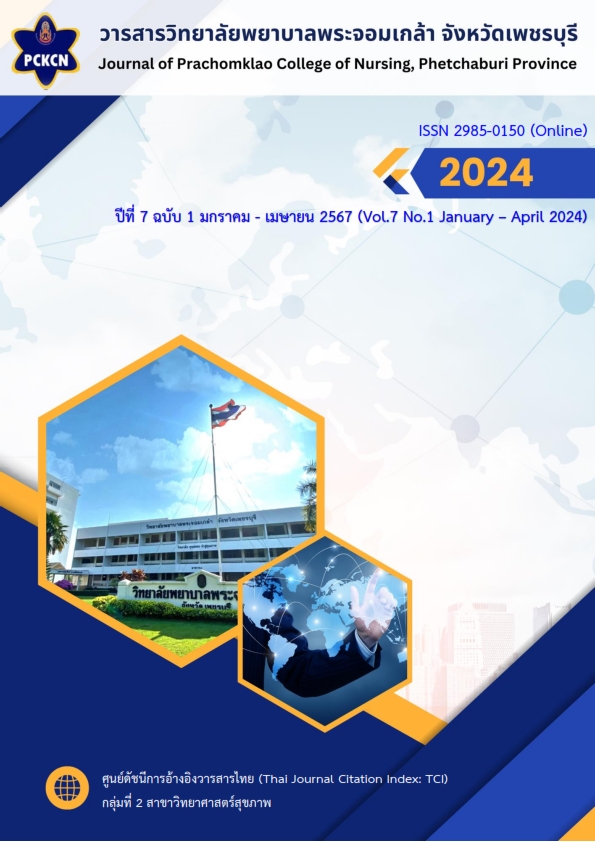ผลของโปรแกรมส่งเสริมแรงจูงใจร่วมกับแอปพลิเคชันไลน์ ต่อพฤติกรรมความร่วมมือในการรักษา และระดับเซลล์เม็ดเลือดขาวชนิดซีดีโฟร์ ในผู้ติดเชื้อเอชไอวีรายใหม่ โรงพยาบาลทั่วไป จังหวัดสมุทรสาคร
Main Article Content
บทคัดย่อ
การวิจัยกึ่งทดลองนี้ มีวัตถุประสงค์เพื่อศึกษาผลของโปรแกรมส่งเสริมแรงจูงใจร่วมกับแอปพลิเคชันไลน์ต่อพฤติกรรมความร่วมมือในการรักษา และระดับเซลล์เม็ดเลือดขาวชนิดซีดีโฟร์ ในผู้ติดเชื้อเอชไอวีรายใหม่ โรงพยาบาลทั่วไป จังหวัดสมุทรสาคร กลุ่มตัวอย่างเป็นผู้ที่ได้รับการวินิจฉัยจากแพทย์ว่าติดเชื้อไวรัสเอชไอวีรายใหม่ที่มารับบริการที่คลินิกรับยาต้านไวรัส โรงพยาบาลทั่วไป จังหวัดสมุทรสาคร คัดเลือกกลุ่มตัวอย่างแบบเจาะจง จำนวน 30 คน แบ่งเป็นกลุ่มทดลอง และกลุ่มเปรียบเทียบกลุ่มละ 15 คน เครื่องมือที่ใช้ในการวิจัย ได้แก่ 1) โปรแกรมส่งเสริมแรงจูงใจร่วมกับแอปพลิเคชันไลน์ที่พัฒนาขึ้นตามกรอบแนวคิดทฤษฎีแรงจูงใจเพื่อป้องกันโรคของโรเจอร์ มีค่าดัชนีความตรงตามเนื้อหาเท่ากับ .98 และ 2) แบบสอบถามพฤติกรรมความร่วมมือในการรักษา มีค่าความเที่ยงสัมประสิทธิ์แอลฟาของครอนบาคเท่ากับ .84 วิเคราะห์ข้อมูลโดยใช้สถิติเชิงพรรณนา สถิติการทดสอบที การทดสอบวิลคอกซัน และแมน–วิทนีย์ ยู
ผลการวิจัยพบว่า กลุ่มทดลองผู้ติดเชื้อเอชไอวีรายใหม่มีคะแนนเฉลี่ยพฤติกรรมความร่วมมือในการรักษา และระดับเม็ดเลือดขาวชนิดซีดีโฟร์ภายหลังเข้าร่วมโปรแกรมสูงกว่าก่อนเข้าร่วมโปรแกรม และสูงกว่ากลุ่มเปรียบเทียบ อย่างมีนัยสำคัญทางสถิติที่ระดับ .001
บุคลากรทางการแพทย์ควรนำโปรแกรมส่งเสริมแรงจูงใจร่วมกับแอปพลิเคชันไลน์ ไปประยุกต์ใช้เป็นแนวปฏิบัติสำหรับการดูแลผู้ติดเชื้อเอดส์รายใหม่ของโรงพยาบาล หรือนำไปใช้กับผู้ติดเชื้อเอชไอวีที่ไม่ให้ความร่วมมือในการรักษา หรือมารับการรักษาล่าช้า
Downloads
Article Details

อนุญาตภายใต้เงื่อนไข Creative Commons Attribution-NonCommercial-NoDerivatives 4.0 International License.
เนื้อหาและข้อมูลที่เผยแพร่ในวารสารวิทยาลัยพยาบาลพระจอมเกล้า จังหวัดเพชรบุรี ถือเป็นข้อคิดเห็นและความรับผิดชอบของผู้นิพนธ์บทความโดยตรง บทความ เนื้อหา ข้อมูล รูปภาพ ฯลฯ ที่ได้รับการเผยแพร่ในวารสารนี้ ถือเป็นลิขสิทธิ์ของวารสารฯ หากบุคคลหรือหน่วยงานใดต้องการนำทั้งหมดหรือส่วนหนึ่งส่วนใดไปเผยแพร่หรือเพื่อกระทำการใด ๆ จะต้องอ้างอิงวิทยาลัยพยาบาลพระจอมเกล้า จังหวัดเพชรบุรี ทุกครั้ง
เอกสารอ้างอิง
Bureau of epidemiology, Ministry of Public Health. (2022). Summary of the situation of AIDS patients and HIV infection in Thailand. Ministry of Public Health. (in Thai)
Chaiyasit, Y., Thong-on, R., Dumrongpakapakorn, P., Donprapeng, B., Boonkong, D., & Somkumlung, P. (2013). The strategies to improve antiretroviral drug adherence: A literature review. Princess of Naradhiwas University Journal, 5(3), 13–24. (in Thai)
Dalodom, K., Phachuen, O., & Bunsuya, C. (2018). Social support, depression, mental health power, and self-care behavior of people living with HIV who come to receive services at a clinic. Quality of Life and Law Journal, 14(2), 12–26. (in Thai)
Department of Disease Control. (2017). Guidelines for testing, treatment, and prevention of HIV infection in Thailand. National Office of Buddhism. (in Thai)
Finitsis, D. J., Pellowski, J. A., & Johnson, B. T. (2014). Text message intervention designs to promote adherence to antiretroviral therapy (ART): A meta-analysis of randomized controlled trials. PLOS ONE, 9(2), Article 88166. https://doi.org/10.1371/journal.pone.0088166
Fisher, J. D., Amico, K. R., & Fisher, W. A. (2008). The information-motivation-behavioral skills model of antiretroviral adherence and its applications. Current HIV/AIDS Reports, 5(4), 193–203.
Joint United Nations Programme on HIV/AIDS (UNAIDS). (2018). UNAIDS DATA 2018. https://www.unaids.org/sites/default/files/media_asset/unaids-data-2018_en.pdf
Kanters, S., Park, J. J., Chan, K., Socias, M. E., Ford, N., Forrest, J. I., Thorlund, K., Nachega, J. B., & Mills, E. J. (2017). Interventions to improve adherence to antiretroviral therapy: A systematic review and network meta-analysis. The Lancet HIV, 4(1), 31-40. https://doi.org/10.1016/S2352-3018(16)30206-5
Koisaranupab, N., Sridan, W., & Samrannet, W. (2022). The role of nurses in promoting the health of people living with HIV/AIDS according to Pender's health promotion model. Journal of MCU Nakhondhat, 9(2), 14–31. (in Thai)
MacKay, B. C. (1989). AIDS and protection motivation theory (PMT): Effects of imagined scenarios on intent to use condoms. New Mexico State University.
Nanthachan, N., Kasatpibal, N., & Viseskul, N. (2015). Effect of information provision, motivation, and skill development on antiretroviral adherence among youths living with HIV. Nursing Journal CMU, 42(3), 72–83. (in Thai)
National Health Security Office (NHSO). (2022). National HIV/AIDS Services Information System or National AIDS Program: NAP. http://napdl.nhso.go.th/NAPWebReport/LoginServlet
Phakdee, K. (2014). HIV infection and AIDS and current treatment guidelines. Variety for Health@Rama, 17, 4–6. (in Thai)
Pongkatgran, A., & Tipwareerom, W. (2018). Effects of self-efficacy program of using hermit exercise towards exercise habits and immune system level (CD4) in AIDS patients. Journal of Nursing and Health Sciences, 12(1), 58-71 (in Thai)
Rakrungtha, K. (2014). Guidelines for testing, treatment, and prevention of HIV infection in Thailand. Agricultural Cooperatives Association of Thailand. (in Thai)
Rogers, R. W. A. (1983). Protection Motivation Theory. Health Education Research Theory and Practice. The Journal of Psychology, 9(11), 93–114.
Somya, M., Kitsripisarn, S., & Bannaasan, B. (2020). The effects of a motivation enhancing program on adherence behaviors to the treatment regimens and sputum exam among newly diagnosed pulmonary tuberculosis patients. Journal of Nursing Science Chulalongkorn University, 32(1), 24-36. (in Thai)
Suntharapot, S., & Sribundit, N. (2022). Effectiveness of text messaging via application Line on adherence to antiretroviral drug among HIV and Aids patients in Khaoyoi Hospital Phetchaburi. Thai Bulletin of Pharmaceutical Sciences, 17(2), 83-99. (in Thai)
Tantawut, S., Tinapa, W., & Chaousirikul, C. (2016). Effects of a program on correction and persistence of antiretroviral treatment to improve adherence and drug safety in HIV/AIDs patients at Uthumpornphisai Hospital, Sisaket Province, Thailand. Journal of Health Science, 25(4), 696-703. (in Thai)
Veerakul, K. (2011). Factors affecting the compliance of HIV/AIDS patients with antiretroviral therapy at Thung Tako Hospital in Chumphon Province. [Unpublished master thesis]. Sukhothai Thammathirat Open University. (in Thai)
World Health Organization. (2003). Adherence to long-term therapies: Evidence for action. https://apps.who.int/iris/handle/10665/42682


